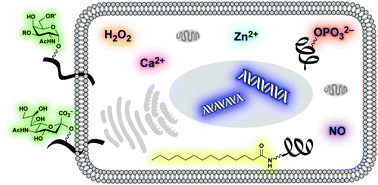Imaging beyond the proteome
Abstract
Imaging technologies developed in the early 20th century achieved contrast solely by relying on macroscopic and morphological differences between the tissues of interest and the surrounding tissues. Since then, there has been a movement toward imaging at the cellular and molecular level in order to visualize biological processes. This rapidly growing field is known as molecular imaging. In the last decade, many methodologies for imaging proteins have emerged. However, most of these approaches cannot be extended to imaging beyond the proteome. Here, we highlight some of the recently developed technologies that enable imaging of non-proteinaceous molecules in the cell: lipids, signalling molecules, inorganic ions, glycans, nucleic acids, small-molecule metabolites, and protein post-translational modifications such as phosphorylation and methylation.

- This article is part of the themed collection: Bioorthogonal and click chemistry: Celebrating the 2022 Nobel Prize in Chemistry

 Please wait while we load your content...
Please wait while we load your content...